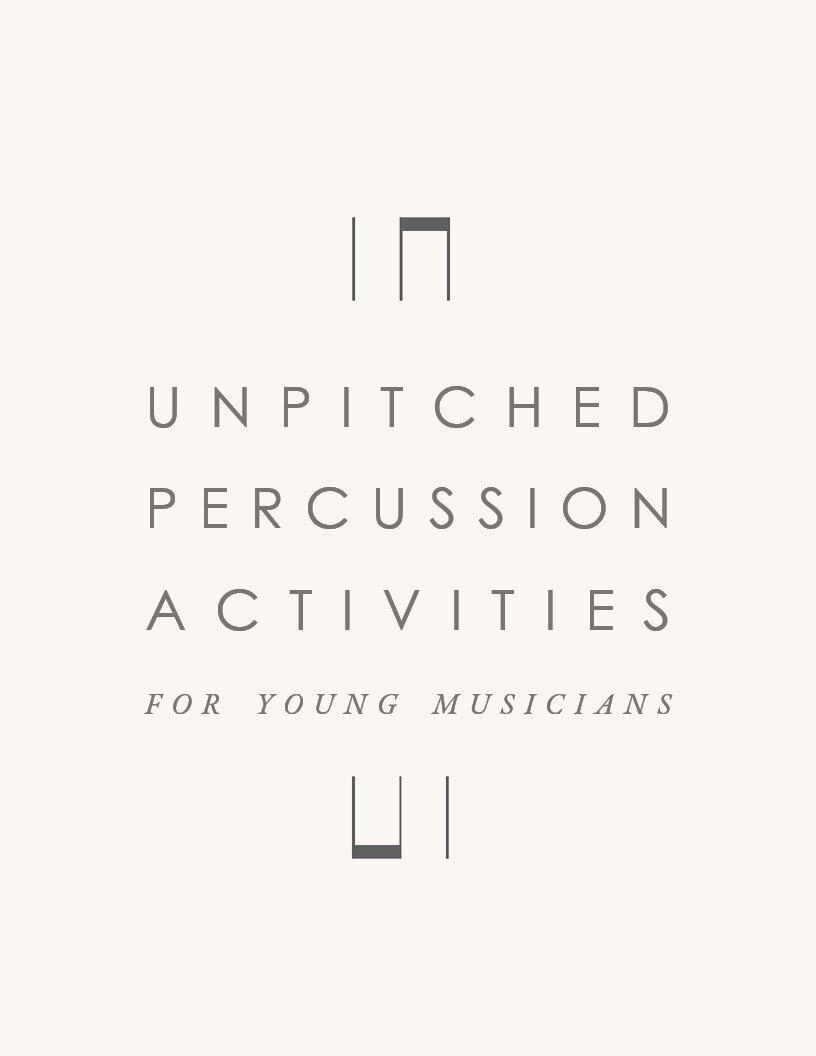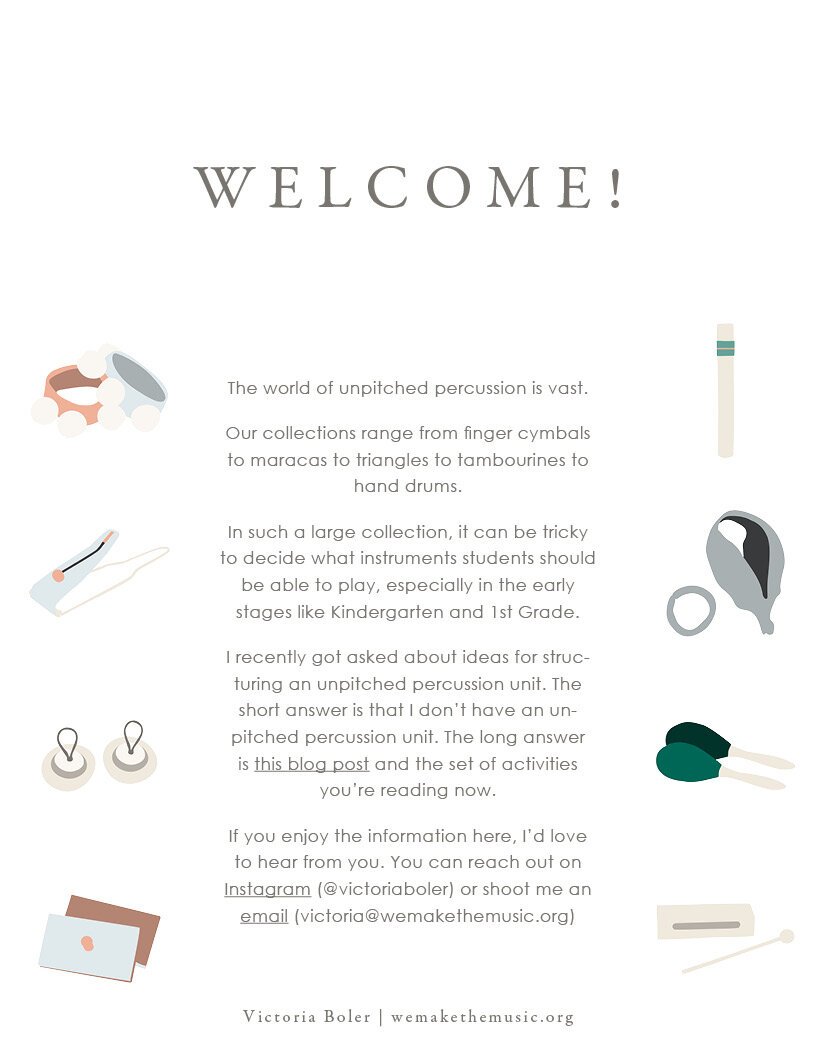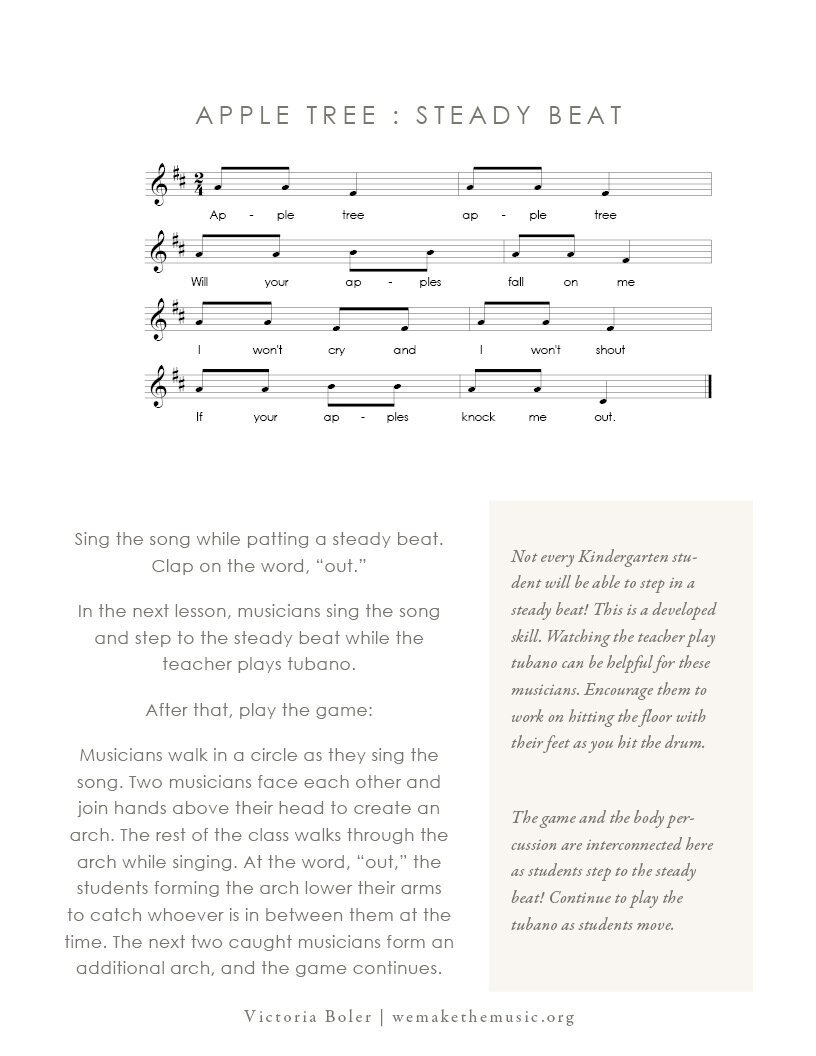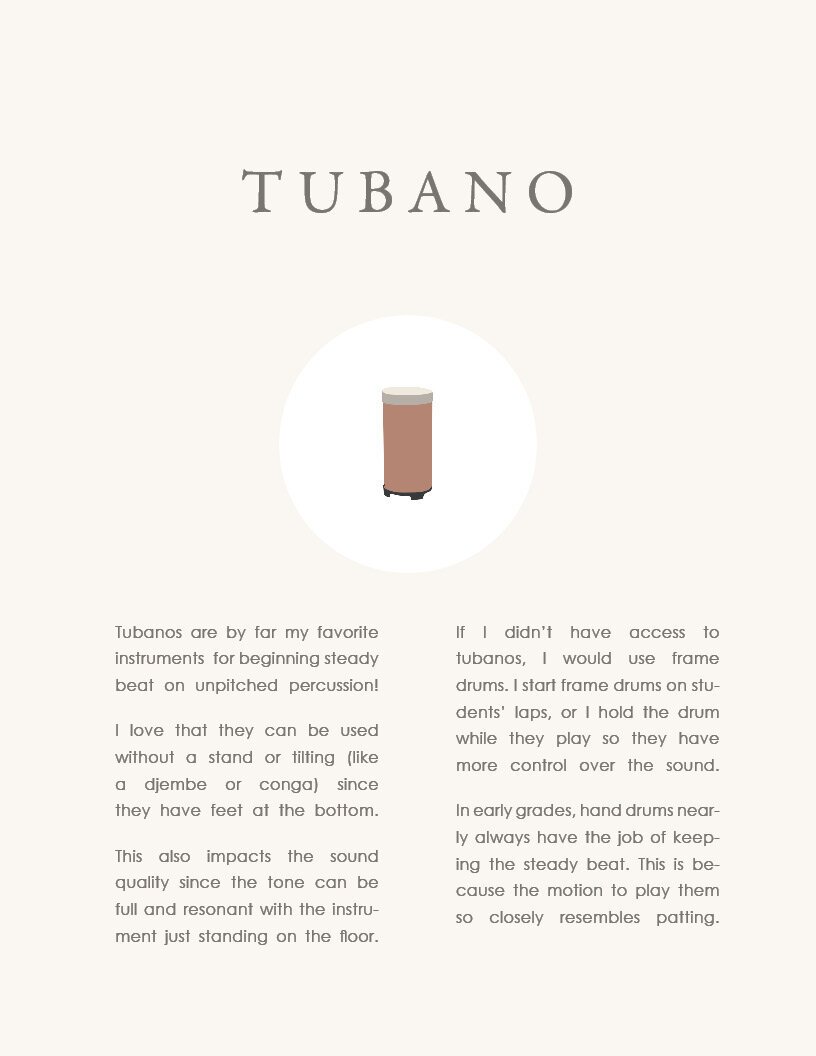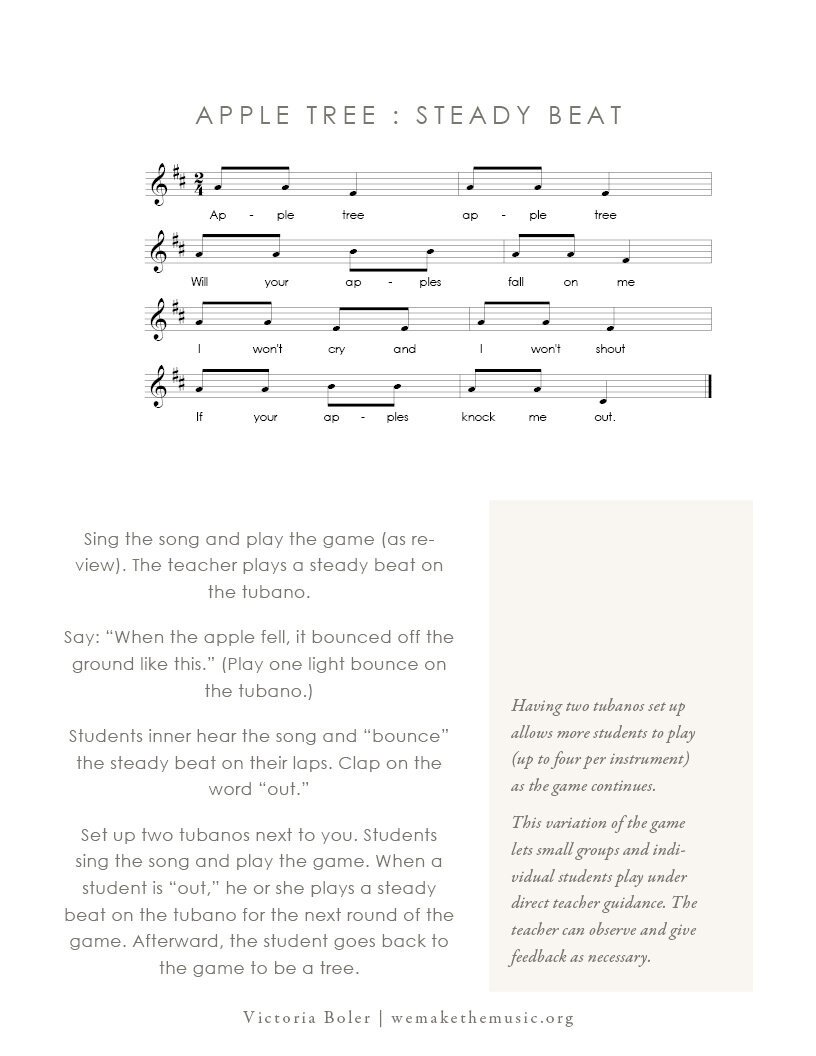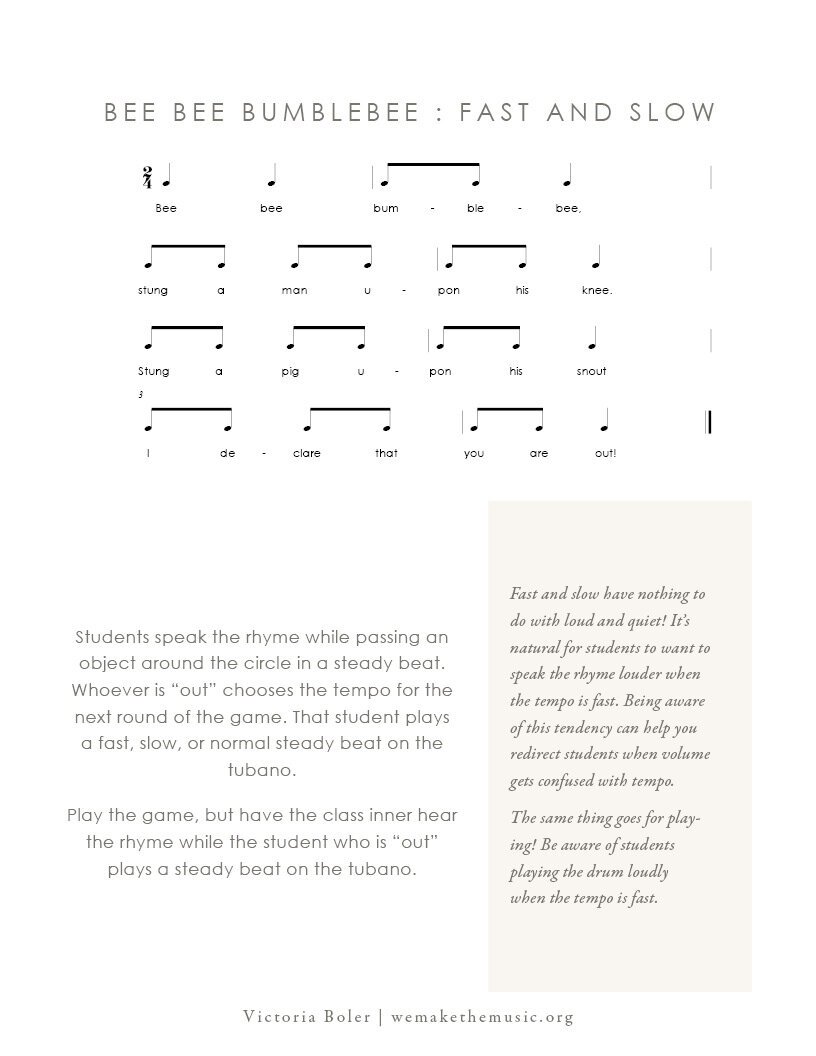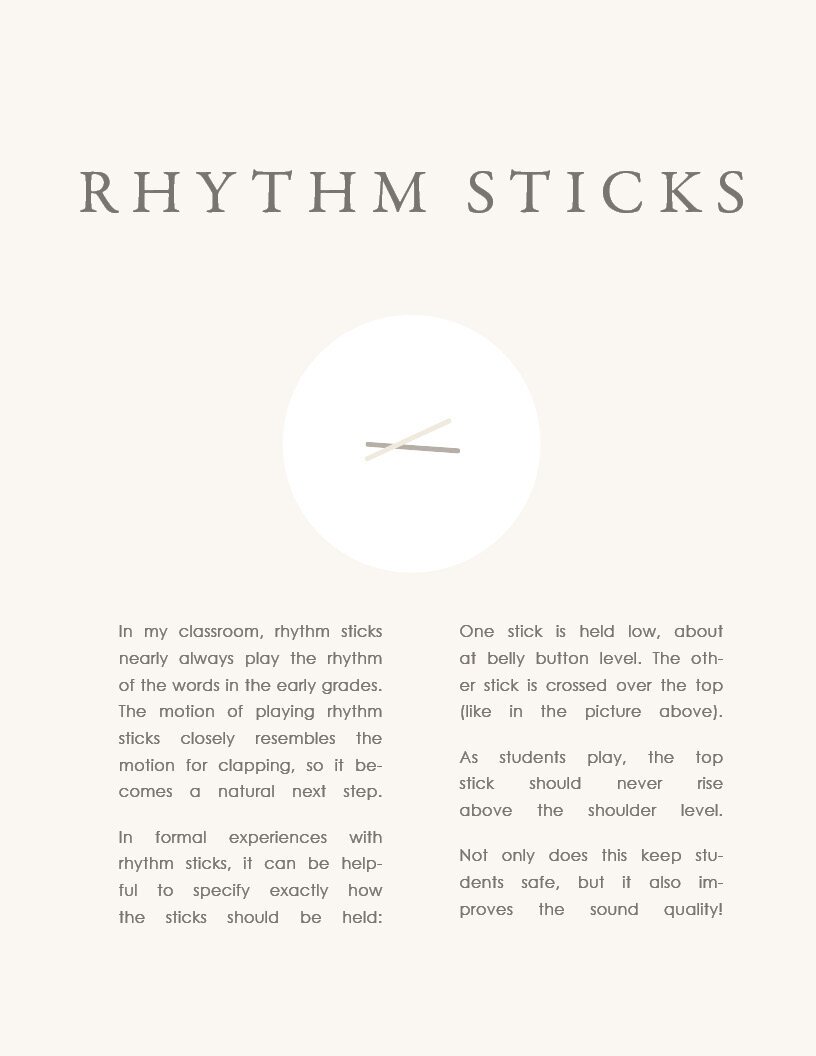Beginning Unpitched Percussion in Early Elementary Music
“Hi, Victoria!
I’m looking for some resources to teach percussion instruments in kindergarten. Do you have any units about types of instruments like djembes, triangles, maracas, etc.?
Thanks!”
The short answer to this email is that I don’t teach percussion as its own unit. The long answer is this blog post, and the collection of activities at the end.
Let’s jump in!
The world of unpitched percussion is vast. Our collections range from finger cymbals to maracas to triangles to tambourines to hand drums. In such a large collection, it can be tricky to decide what instruments students should be able to play, especially in the early stages like Kindergarten and 1st grade.
This is my process for how I choose what instruments to introduce to young musicians, and at what time in my year.
Choosing Instruments for Young Musicians
When I choose classroom instruments for my students, I consider the musical purpose of the activity and where students might be in terms of physical development. That informs my options I give throughout each grade level and throughout each month of the year.
The Musical Purpose
When I look at my curriculum outline, scope and sequence, song lists, and concept plans, it is crystal clear to me which songs have been chosen with which specific musical concepts in mind. Because of these long-range plans, I can also be clear on the specific musical outcome I want students to achieve or explore.
Since these musical decisions come as a result of my curriculum outline, there is a natural place in the curriculum these instruments will be featured. This is true not only for Kindergarten, but for continuing grades as well.
That musical outcome drives the decision of what instruments to choose. What is the musical outcome? What are the sound properties of the instrument? Thinking through these questions gives me clarity.
For example, if I want each student to leave class with the kinesthetic experience of keeping a steady beat, I look for instruments that have a natural ability to maintain a consistent tempo. In this case, choosing a hand drum over a thunder tube makes sense.
If I want to explore metals, I consider whether I want something to be articulate or a wash of sound. This can guide my decision in using finger cymbals or jingle bell bracelets.
What is the musical outcome? What are the sound properties of the instrument? Thinking through these questions gives me clarity.
Physical Requirements:
Distance and Velocity:
Unpitched percussion success at this age has a lot to do with hand-eye coordination.
When they play unpitched percussion, students must make a judgement about the amount of space between the two objects that are to be struck together. They also need to decide the velocity, or how quickly they need to move in order to strike at the correct time.
When we consider these two factors - distance and velocity - we start to see some of the variables in a child’s experience playing an unpitched percussion instrument.
Physical Information:
Another consideration is how much control the student has over the playing process. Some instruments are naturally going to be more accessible in early playing experiences.
Here’s an example with three common kindergarten instrumental tasks: patting knees, playing a drum, and playing a triangle. Let’s imagine these students are working on performing a steady beat.
When we pat our knees to keep a steady beat, there are two sources of kinesthetic information: the palm of our hand, and the knee itself. Kinesthetic information from these two sources allow us to assess the tempo (where we land in time) and velocity (how hard we land) of the strike.
When we play a tubano, we remove half the kinesthetic information we were getting by patting our knees. There is no longer a sensation from the knee, so all the decisions must be made by sensations from the hand.
When we play a triangle, we remove any direct kinesthetic information about tempo and velocity.
These details seem minute, and in some ways they are. However, especially with young musicians developing their sense of steady beat, it’s helpful to consider the relationship between the task we are asking them to perform, and the amount of information we are allowing them to take in about that task.
Unpitched Percussion Sequence:
When I think through the musical purpose and physical parameters around unpitched percussion, a logical sequence for unpitched percussion instruments becomes clear.
This is based on my own scope and sequence for a “typical” kindergarten year.
After the initial experiences with the instruments below, we can explore the rhythmic concepts with other instruments. I don’t hold on too tightly to this sequence, but it serves as a helpful framework for how to structure the learning process.
In Kindergarten, rhythmic concepts include steady beat, fast and slow, long and short, rhythm of the words, and rhythm vs beat. The sequence below is designed to follow those formal rhythmic concepts.
Body percussion: Pat, stamp, clap, snap
We have a lot of body percussion experiences before playing instruments, especially patting and stamping before steady beat or when working with fast and slow.
We do a lot of clapping and snapping before playing instruments for long and short, the rhythm of the words, and rhythm vs beat.
Hand drums: Tubano, conga, djembe, frame drums on the lap or held by the teacher
Tubanos are by far my favorite unpitched percussion instrument! Here is the specific model I recommend.
I love that they can be used without a stand or tilting (like a djembe or conga) since they have feet at the bottom. This also impacts the sound quality since the sound can be full and resonant with the instrument just standing on the floor.
If I didn’t have access to tubanos, I would use frame drums. These are incredibly cost efficient and you can use them in so many different ways. For young students, it’s impractical to expect them to hold the instrument steady in one hand and accurately strike with the other during their first playing experiences. Because of this, I start frame drums on students’ laps, or I hold the drum while they play.
In early grades, hand drums nearly always have the job of keeping the steady beat. This is because the motion to play them so closely resembles patting.
Woods: Rhythm sticks, temple blocks, wood blocks
In my classroom, rhythm sticks nearly always play the rhythm of the words in the early grades. The motion of playing rhythm sticks closely resembles the motion for clapping, so they become a natural next step.
Woods provide a sharp contrast in timbre from hand drums. The difference in timbre is incredibly effective when working on the difference between rhythm and beat.
Outside the sequence:
We play other unpitched percussion instruments in Kindergarten as well.
Jingle bells, tambourines, finger cymbals, maracas, and more make it into our musical experiences. It’s common for these to be used informally (like for a soundscape) more than formal rhythmic activities.
In these exploratory activities, students might search for the best way to make a sound on the instrument. I might challenge them to come up with three ways to safely make a sound, then share their ideas with a partner.
As I move through the curriculum in later grades, other unpitched percussion instruments will naturally be highlighted as they align with the musical purpose of an activity, and as students continue their physical development.
“Hi, Victoria!
I’m looking for some resources to teach percussion instruments in kindergarten. Do you have any units about types of instruments like djembes, triangles, maracas, etc.?
Thanks!”
I don’t approach unpitched percussion as its own isolated unit.
Rather, unpitched percussion experiences are naturally embedded into musical processes like singing, speaking, playing games, and improvising as another way to explore musical elements.
Unpitched Percussion Activities PDF
If you’re looking for specific activities that are musically purposeful and developmentally appropriate, I’ve collected a few of my favorites in the PDF below.
When you download, you’ll also be signed up to get more resources like this one from time to time. I only send emails that I would be thrilled to get myself!
